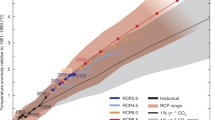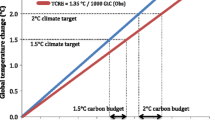Abstract
This paper reports the main results of an assessment of the global-scale implications of the stabilisation of atmospheric CO2 concentrations at 750 ppm (by 2250) and 550 ppm (by 2150), in relationto a scenario of unmitigated emissions. The climate change scenarios were derived from simulation experiments conducted with the HadCM2 global climate model and forced with the IPCC IS92a, S750 and S550 emissions scenarios. The simulated changes in climate were applied to an observed global baseline climatology, and applied with impacts models to estimate impacts on natural vegetation, water resources, coastal flood risk and wetland loss, crop yield and food security, and malaria. The studies used a single set of population and socio-economic scenarios about the future that are similar to those adopted in the IS92a emissions scenario.An emissions pathway which stabilises CO2 concentrations at 750 ppmby the 2230s delays the 2050 temperature increase under unmitigated emissions by around 50 years. The loss of tropical forest and grassland which occurs by the 2050s under unmitigated emissions is delayed to the 22nd century, and the switch from carbon sink to carbon source is delayed from the 2050s to the 2170s. Coastal wetland loss is slowed. Stabilisation at 750 ppm generally has relatively little effect on the impacts of climate change on water resource stress, and populations at risk of hunger or falciparum malaria until the 2080s.A pathway which stabilises CO2 concentrations at 550 ppm by the 2170s delays the 2050 temperature increase under unmitigated emissions by around 100 years. There is no substantial loss of tropical forest or grassland, even by the 2230s, although the terrestrial carbon store ceases to act as a net carbon sink by around 2170 (this time because the vegetation has reached a new equilibrium with the atmosphere). Coastal wetland loss is slowed considerably, and the increase in coastal flood risk is considerably lower than under unmitigated emissions. CO2 stabilisation at 550 ppm reduces substantially water resource stress, relative to unmitigated emissions, but has relatively little impact on populations at risk of falciparum malaria, and may even cause more people to be at risk of hunger. While this study shows that mitigation avoids many impacts, particularly in the longer-term (beyond the 2080s), stabilisation at 550 ppm appears to be necessary to avoid or significantly reduce most of the projected impacts in the unmitigated case.
Similar content being viewed by others
References
Arnell, N. W.: 1999a, ‘Climate Change and Global Water Resources’, Global Environ. Change 9, S31–S49.
Arnell, N.W.: 1999b, ‘A SimpleWater Balance Model for the Simulation of Streamflow over a Large Geographic Domain’, Journal of Hydrology 217, 314–335.
Bos, E., Vu, M. T., Massiah, E., and Bulatao, R. A.: 1994, World Population Projections 1994–1995: Estimates and Projections with Related Demographic Statistics,World Bank, The Johns Hopkins University Press, New York.
Carnell, R. and Senior, C.A.: 1998, ‘Changes in Mid-Latitude Variability Due to Increasing Greenhouse Gases and Sulphate Aerosols’, Clim. Dyn. 14, 369–383.
Collins, M.: 2000, ‘The El Nino-Southern Oscillation in the Second Hadley Centre Coupled Model and its Response to Greenhouse Warming’, J. Climate 13, 1299–1312.
Energy Modeling Forum: 1995, Second Round Study Design for EMF 14: Integrated Assessment of Global Climate Change, Working Paper 14, Energy Modeling Forum, March 1995.
Friend, A. D. and White, A.: 2000, ‘Evaluation and Analysis of a Dynamic Terrestrial Ecosystem Model under Pre-Industrial Conditions at the Global Scale’, Global Biogeochem. Cycles, 14, 1173–1190.
Friend, A. D., Stevens, A. K., Knox, R. G., and Cannell, M. G. R.: 1997, ‘A Process Based, Terrestrial Biosphere Model of Ecosystem Dynamics (HYBRID v3.0)’, Ecol. Modelling 95, 249–287.
Henderson-Sellers, A., Zhang, H., Berz, G., and Emanuel, K., et al.: 1998, ‘Tropical Cyclones and Global Climate Change: A Post-IPCC Assessment’, Bull. Amer. Meteorol. Soc. 79, 19–38.
Hoozemans, F. M. J., Marchand, M., and Pennekamp, H. A.: 1993, A Global Vulnerability Analysis: Vulnerability Assessment for Population, Coastal Wetlands and Rice Production on a Global Scale, Delft Hydraulics, The Netherlands, Second Edition.
Hulme, M., Mitchell, J. F. B., Ingram, M., Johns, T., New, M., and Viner, D.: 1999, ‘Climate Change Scenarios for Global Impacts Studies’, Global Environ. Change 9, S3–S19.
IPCC 1997, Stabilisation of Atmospheric Greenhouse Gases: Physical, Biological and Socioeconomic Implications, Intergovernmental Panel on Climate Change Technical Paper III, Intergovernmental Panel on Climate Change.
IPCC 2000, Special Report on Emissions Scenarios, Intergovernmental Panel on Climate Change, Cambridge University Press, Cambridge.
Johns, T. C., Carnell, R. E., Crossley, J. E., Gregory, J. M., Mitchell, J. F. B., Senior, C. A., Tett, S. F. B., and Wood, R. A.: 1997, ‘The Second Hadley Centre Coupled Ocean-Atmosphere GCM: Model Description, Spinup and Validation’, Clim. Dyn. 13, 103–134.
Klein, R. J. T. and Nicholls, R. J.: 1999, ‘Assessment of Coastal Vulnerability to Sea-Level Rise’, Ambio 28, 182–187.
Krol, M., Alcamo, J., and Leemans, R.: 1997, ‘Global and Regional Impacts of Stabilising Atmospheric CO2’, Mitigation and Adaptation Strategies for Global Change 1, 341–361.
Knutson, T. R., Tuleya, R. E., and Kurihara, Y.: 1998, ‘Simulated Increase in Hurricane Intensities in a CO2-Warmed Climate’, Science 279, 1018–1020.
Leggett, J. A., Pepper, W. J., and Swart, R. J.: 1992, ‘Emissions Scenarios for IPCC - an Update’, in Houghton, J. T. et al. (eds), Climate Change 1992 - The Supplementary Report to the IPCC Scientific Assessment, Cambridge University Press, Cambridge, pp. 69–95.
Martens, P., Kovats, S., Nijhof, S., and de Vries, P., et al.: 1999, ‘Climate Change and Future Populations at Risk of Malaria’, Global Environ. Change 9, S89–S107.
McMichael, A., Haines, A., Sloof, R., and Kovats, S. (eds.): 1996, Climate Change and Human Health, World Health Organisation, Geneva, p. 297.
Mitchell, J. F. B., Johns, T. C., Eagles, M., Ingram, W. J., and Davies, R. A.: 1999, ‘Towards the Development of Climate Change Scenarios’, Clim. Change 41, 547–581.
Mitchell, J. F. B., Johns, T. C., Ingram, W. J., and Lowe, J. A.: 2000, ‘The Effect of Stabilising Atmospheric Carbon Dioxide Concentrations on Global and Regional Climate Change’, Geophys. Res. Lett. 27, 2997–3100.
New, M. G., Hulme, M., and Jones, P. D.: 1999, ‘Representing Twentieth Century Space-Time Climate Variability, Part 1: Development of a 1961–1990 Mean Monthly Terrestrial Climatology’, J. Climate 12, 829–856.
Nicholls, R. J., Hoozemans, F. M. J., and Marchand, M.: 1999, ‘Increasing Flood Risk and Wetland Losses Due to Global Sea Level Rise: Regional and Global Analyses’, Global Environ. Change 9, S69–S87.
Parry, M. L., Arnell, N. W., Hulme, M., Nicholls, R., and Livermore, M.: 1998, ‘Adapting to the Inevitable’, Nature 395, p. 741.
Parry, M. L., Rosenzweig, C., Iglesias, A., Fischer, G., and Livermore, M. T. J.: 1999, ‘Climate Change and World Food Security: A New Assessment’, Global Environ. Change 9, S51–S67.
Raskin, P., Gleick, P., Kirshen, P., Pontius, G., and Strzepek, K.: 1997, Water Futures: Assessment of Long-range Patterns and Problems, Background Report for the Comprehensive Assessment of the Freshwater Resources of the World, Stockholm Environment Institute, Stockholm, p. 78.
Rosenzweig, C. and Parry, M. L.: 1994, ‘Potential Impacts of Climate Change on World Food Supply’, Nature 367, 133–138.
Shiklomanov, I. A.: 1998, Asssessment ofWater Resources andWater Availability in the World, Background Report for the Comprehensive Assessment of the Freshwater Resources of the World, Stockholm Environment Institute, Stockholm, p. 88.
White, A., Cannell, M. G. R., and Friend, A. D.: 1999, ‘Climate Change Impacts on Ecosystems and the Terrestrial Carbon Sink: A New Assessment’, Global Environ. Change 9, S21–S30.
White, A., Cannell, M. G. R., and Friend, A. D.: 2000, ‘CO2 Stabilisation, Climate Change and the Terrestrial Carbon Sink’, Global Change Biology 6, 817–833.
Wigley, T. M. L.: 1998, ‘The Kyoto Protocol: CO2, CH4 and Climate Implications’, Geophys. Res. Lett. 25, 2285–2288.
Wigley, T. M. L. and Raper, S. C. B.: 1993, ‘Future Changes in Global Temperature and Mean Sea Level’, in Warrick, R. A., Barrow, E. M., and Wigley, T. M. L. (eds.), Climate and Sea Level Change: Observations, Projections and Implications, Cambridge University Press, Cambridge, pp. 111–133.
Wigley, T. M. L., Richels, L., and Edmonds, J. A.: 1996, ‘Economic and Environmental Choices in the Stabilisation of Atmospheric CO2 Concentrations’, Nature 379, 242–245.
World Meteorological Organisation 1997, Comprehensive Assessment of the Freshwater Resources of the World, WMO, Geneva.
Author information
Authors and Affiliations
Rights and permissions
About this article
Cite this article
Arnell, N.W., Cannell, M.G.R., Hulme, M. et al. The Consequences of CO2 Stabilisation for the Impacts of Climate Change. Climatic Change 53, 413–446 (2002). https://doi.org/10.1023/A:1015277014327
Issue Date:
DOI: https://doi.org/10.1023/A:1015277014327




